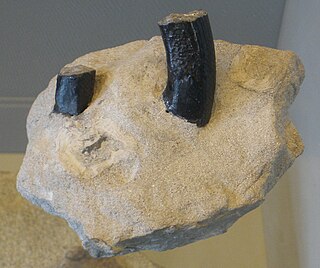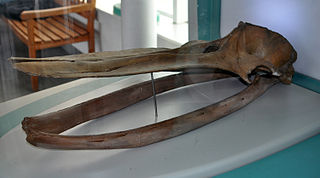
Lancetfishes are large oceanic predatory ray-finned fishes in the genus Alepisaurus in the monogeneric family Alepisauridae.

Ouranopithecus is a genus of extinct Eurasian great ape represented by two species, Ouranopithecus macedoniensis, a late Miocene hominoid from Greece and Ouranopithecus turkae, also from the late Miocene of Turkey.

Percrocuta is an extinct genus of hyena-like feliform carnivores. It lived in Europe, Asia, and Africa, during the Miocene epoch.

Anchitheriomys is an extinct member of the beaver family, Castoridae. It inhabited North America and Eurasia during the middle Miocene. The name of the genus comes from Anchitherium, an extinct genus of horses, and the Greek word for mouse, μῦς (mys), thus meaning "Anchitherium's mouse", because the fossils of both genera usually co-occur.
Hoazinoides is an extinct genus of birds from the Middle Miocene (Laventan) from the "Monkey Beds" of the Villavieja Formation of the Honda Group at the Konzentrat-Lagerstätte of La Venta, Colombia.

Argillichthys is an extinct marine lizardfish known from the Lower Eocene. It contains a single species, A. toombsi, from the Ypresian-aged London Clay Formation in England. It is known from a skull. It is thought to be a stem-member of Synodontidae.

Brygmophyseter, known as the biting sperm whale, is an extinct genus of toothed whale in the sperm whale family with one species, B. shigensis. When it was first described in 1994, the species was placed in the genus Scaldicetus based on tooth morphology, but this was later revised in 1995. In 2006, it was classified into the genus Naganocetus, which is considered to be a junior synonym. The only known specimen, a nearly complete skeleton, was dated to be around 16–15 million years old. Brygmophyseter is thought to have been 6.5–7 meters (21–23 ft) long, and it probably had 11 or 12 teeth in the upper and lower jaws. Brygmophyseter is part of a group of macroraptorial sperm whales which tended to be apex predators using their large teeth to catch struggling prey such as whales. It had a spermaceti organ which was probably used for biosonar like in the modern sperm whale. The whale has made an appearance on The History Channel's TV series Jurassic Fight Club.
Hesperogavialis is an extinct genus of gryposuchine gavialid. Fossils have been found from Venezuela and Brazil that date back to the Middle to Late Miocene. Although Hesperogavialis is one of the best known gavialoids from South America, the posterior portion of the skull is still unknown, making any attempts at classification within the family somewhat more difficult than other gavialoids in which much of the skull is present. The genus possibly comprises three species. The type species, H. cruxenti, has been found in the Urumaco Formation in Venezuela. A second possible species, named H. bocquentini, has been described from the Solimões Formation in Acre, Brazil, and can be distinguished from H. cruxenti by the asymmetry seen in the anterior portion of the nasals and the small distance between alveoli. A third species can be recognized from the same locality in Acre, although a formal name has yet to be given to it.

Piscobalaena is an extinct genus of cetaceans, which lived from the Middle to Late Miocene epochs in Peru and Florida. Its fossils have been found in the Pisco Formation of Peru and the Bone Valley Formation of Florida. At least some individuals of this diminutive whale were preyed on by the shark O. megalodon.
Centenariosuchus is an extinct genus of caimanine crocodylian known from the Miocene of the Panama Canal Zone of Panama. It contains a single species, Centenariosuchus gilmorei, that was named in 2013 in honor of the upcoming centennial anniversary of the digging of the Panama Canal. Two fossil specimens consisting of skull fragments were found in the Early to Middle Miocene Cucaracha Formation in 2009 and 2011, and may belong to a single individual. The species is diagnosed by a combination of skull features that it shares with basal caimans like Tsoabichi, Eocaiman, Culebrasuchus, and the living genus Paleosuchus, as well as more derived caimans such as those in the genus Caiman. One feature that distinguishes Centenariosuchus from all other caimans is the straight outer margin of a hole on the underside of the skull called the suborbital fenestra. According to one phylogenetic analysis of caimanine relationships, Centenariosuchus falls within a clade or evolutionary grouping of caimans that includes the very large and highly specialized forms Purussaurus and Mourasuchus, known from the Miocene of South America.

Titanocetus is a genus of extinct cetaceans closely related to the family Cetotheriidae.

Cetotheriopsis is a genus of extinct cetaceans of the family Cetotheriopsidae.

Macrorhineura is an extinct genus of rhineurid amphisbaenian or worm lizard, including the type and only species Macrorhineura skinneri, named in 1970 on the basis of the front half of a skull from the Early Miocene Sharps Formation in Wounded Knee, South Dakota. Although the skull is incomplete, features such as a pointed, shovel-shaped snout indicate that it belongs to the family Rhineuridae. Within Rhineuridae, Macrorhineura is most closely related to Ototriton and Hyporhina, two genera from the Eocene and Oligocene of Colorado and Wyoming, based on the shared feature of equally sized dentary teeth in the lower jaw. Together they form a clade or evolutionary grouping of mid-continental rhineurids, which became isolated from a more western clade of rhineurids that includes Dyticonastis and Spathorhynchus. Rhineurids were relatively common across much of North America during the Paleogene, but their range contracted in the Neogene as the climate became colder, leaving only one living species in Florida, Rhineura floridana. The presence of Macrorhineura in the Miocene shows that mid-continental rhineurids persisted into the Neogene, although by this time their distribution range was already shrinking.

Polymerichthys is an extinct genus of superficially eel-like aulopiform fish known from the late Oligocene to the middle-late Miocene. It contains a single described species, P. nagurai from the Middle Miocene of Japan, though several indeterminate specimens are also known from Russia and Italy.

Caiman wannlangstoni is an extinct species of caiman that lived in what is now the Amazon Basin and surrounding areas during the Middle and Late Miocene. Fossils of C. wannlangstoni have been found in the Pebas Formation near Iquitos in Peru and include partial skulls and isolated skull bones. Other fossils were uncovered from the Urumaco Formation in Venezuela and the Laventan Honda Group of Colombia. The species was first described in 2015. Features that in combination distinguish C. wannlangstoni from other caimans include a deep snout, a wavy upper jaw margin, a large and upward-directed narial opening, and blunt teeth at the back of the jaws. Based on the sizes of the skulls, its estimated body length is about 211 to 227 centimetres.
Liolithax is an extinct genus of dolphin from the Middle Miocene (Serravallian) Temblor Formation of California.

Lophocetus is an extinct genus of dolphin belonging to the clade Delphinida that is known from late Miocene (Tortonian) marine deposits in California and Maryland. Although usually placed in Kentriodontidae, recent studies have found it only distantly related to Kentriodon.
Neoglyptatelus is an extinct genus of xenarthran, belonging to the order Cingulata. It lived from the Middle to the Late Miocene, and its fossilized remains are found in South America.
Villarroelia is an extinct genus of proterotheriid from the Middle Miocene of Colombia.
Brievabradys is an extinct genus of ground sloth belonging to the family Mylodontidae that lived in Colombia during the Middle Miocene. This genus was discovered in the Honda Group of Colombia, in the strata of the Tatacoa Desert in the Huila Department with an approximate age of 13 to 11 million years ago, dating to the Middle Miocene. Brievabradys was described based on a fossilized skull and additional cranial remains found in that area.













